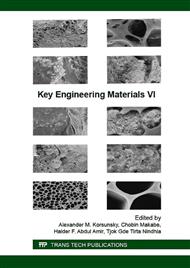[1]
Ozbakkaloglu, T., Lim J. C., and Vincent, T. FRP-confined concrete in circular sections: Review and assessment of stress-strain model. Engineering Structures, 49 (2013) 1068-1088.
DOI: 10.1016/j.engstruct.2012.06.010
Google Scholar
[2]
Ozbakkaloglu, T. and Lim, J. C. Axial compressive behavior of FRP-confined concrete: Experimental test database and a new design-oriented model. Composites Part B, 55 (2013) 607-634.
DOI: 10.1016/j.compositesb.2013.07.025
Google Scholar
[3]
Lim, J.C., and Ozbakkaloglu, T. Confinement model for FRP-confined high-strength concrete, Journal of Composites for Construction, ASCE, 18(4) (2014) 04013058.
DOI: 10.1061/(asce)cc.1943-5614.0000376
Google Scholar
[4]
Lim, J. C., and Ozbakkaloglu, T. Design model for FRP-confined normal- and high-strength concrete square and rectangular columns. Magazine of Concrete Research, 66(20) (2014) 1020-1035.
DOI: 10.1680/macr.14.00059
Google Scholar
[5]
Lim, J.C., and Ozbakkaloglu, T. Lateral strain-to-axial strain relationship of confined concrete. Journal of Structural Engineering, ASCE. 141(5) (2015) 04014141.
DOI: 10.1061/(asce)st.1943-541x.0001094
Google Scholar
[6]
Huang, L., Sun, X., Yan, L., and Zhu, D. Compressive Behavior of Concrete Confined with GFRP Tubes and Steel Spirals. Polymers, 7(5) (2015) 851-875.
DOI: 10.3390/polym7050851
Google Scholar
[7]
Lim, J., and Ozbakkaloglu, T. Hoop strains in FRP-confined concrete columns: experimental observations. " Materials and Structures, 48(9) (2015) 2839-2854.
DOI: 10.1617/s11527-014-0358-8
Google Scholar
[8]
Vincent, T., and Ozbakkaloglu, T. Influence of Shrinkage on Compressive Behavior of Concrete-Filled FRP Tubes: An Experimental Study on Interface Gap Effect. Construction and Building Materials. 75 (2015) 144-156.
DOI: 10.1016/j.conbuildmat.2014.10.038
Google Scholar
[9]
Vincent, T., and Ozbakkaloglu, T. Influence of slenderness on stress-strain behavior of concrete-filled FRP tubes: Experimental study. Journal of Composites for Construction, ASCE, 19(1) (2015) 04014029.
DOI: 10.1061/(asce)cc.1943-5614.0000489
Google Scholar
[10]
Xie, T., and Ozbakkaloglu, T. Behavior of Steel Fiber-Reinforced High-Strength Concrete-Filled FRP Tube Columns under Axial Compression. Engineering Structures. 90 (2015) 158-171.
DOI: 10.1016/j.engstruct.2015.02.020
Google Scholar
[11]
Xie, T., and Ozbakkaloglu, T. Behavior of Recycled Aggregate Concrete-Filled Basalt and Carbon FRP Tubes. Construction and Building Materials. 105 (2016) 132-143.
DOI: 10.1016/j.conbuildmat.2015.12.068
Google Scholar
[12]
Ozbakkaloglu, T., and Saatcioglu, M. Seismic performance of square high-strength concrete columns in FRP stay-in-place formwork. ASCE Journal of Structural Engineering, 133(1) (2007) 44-56.
DOI: 10.1061/(asce)0733-9445(2007)133:1(44)
Google Scholar
[13]
ElGawady, M., Booker, A., and Dawood, H. Seismic behavior of posttensioned concrete-filled fiber tubes. Journal of Composites for Construction, ASCE, 14(5) (2010) 616-628.
DOI: 10.1061/(asce)cc.1943-5614.0000107
Google Scholar
[14]
Idris, Y. and Ozbakkaloglu, T. Seismic behavior of high-strength concrete-filled FRP tube columns. ASCE, Journal of Composites for Construction, 17(6) (2013) 04013013.
DOI: 10.1061/(asce)cc.1943-5614.0000388
Google Scholar
[15]
Yu, T., Wong, Y., Teng, J., Dong, S., and Lam, E. Flexural behavior of Hybrid FRP-concrete-steel Double-skin tubular members. Journal Composite for Construction, ASCE, 10(5) (2006), 443-452.
DOI: 10.1061/(asce)1090-0268(2006)10:5(443)
Google Scholar
[16]
Teng, J. G., Yu, T., Wong, Y. L., and Dong, S. L. Hybrid FRP concrete steel tubular columns: concept and behavior. Construction and Building Materials, 21 (2007) 846-854.
DOI: 10.1016/j.conbuildmat.2006.06.017
Google Scholar
[17]
Wong, Y. L., Yu, T., Teng, J. G., and Dong, S. L. Behaviour of FRP-confined concrete in annular section columns. Composites part B: Engineering, 38 (2008) 451-466.
DOI: 10.1016/j.compositesb.2007.04.001
Google Scholar
[18]
Louk Fanggi, B.A., and Ozbakkaloglu, T. Compressive behavior of aramid FRP-HSC-steel double-skin tubular columns. Construction and Building Materials. 48 (2013) 554-565.
DOI: 10.1016/j.conbuildmat.2013.07.029
Google Scholar
[19]
Albitar, M., Ozbakkaloglu, T., and Louk Fanggi, B.A. Behavior of FRP-HSC-Steel double-skin tubular columns under cyclic axial compression. Journal of Composites for Construction, ASCE, 19(2) (2014) 04014041.
DOI: 10.1061/(asce)cc.1943-5614.0000510
Google Scholar
[20]
Idris, Y., and Ozbakkaloglu, T. Flexural behavior of FRP-HSC-steel composite beams. " Thin-Walled Structures, 80 (2014) 207-216.
DOI: 10.1016/j.tws.2014.03.011
Google Scholar
[21]
Ozbakkaloglu, T., and Idris, Y. Seismic behavior of FRP-high-strength concrete-steel double skin tubular columns. Journal of Structural Engineering, ASCE, 140(6) (2014) 04014019.
DOI: 10.1061/(asce)st.1943-541x.0000981
Google Scholar
[22]
Ozbakkaloglu, T., and Louk Fanggi, B. A. Axial compressive behavior of FRP-concrete-steel double-skin tubular columns made of normal- and high-strength concrete. Journal of Composite for Construction, ASCE, 18(1) (2014) 04013027.
DOI: 10.1061/(asce)cc.1943-5614.0000401
Google Scholar
[23]
Louk Fanggi, B.A., and Ozbakkaloglu, T. Behavior of Hollow and Concrete-Filled FRP-HSC and FRP-HSC-Steel Composite Columns Subjected to Concentric Compression. Advances in Structural Engineering. 18(5) (2015) 715-738.
DOI: 10.1260/1369-4332.18.5.715
Google Scholar
[24]
Louk Fanggi, B.A., and Ozbakkaloglu, T. Square FRP-HSC-Steel Composite Columns: Behavior under Axial Compression. Engineering Structures. 91 (2015) 156-171.
DOI: 10.1016/j.engstruct.2015.03.005
Google Scholar
[25]
Ozbakkaloglu, T. A Novel FRP-Dual-Grade Concrete-Steel Composite Column System. Thin-walled Structures. 96 (2015) 295-306.
DOI: 10.1016/j.tws.2015.08.016
Google Scholar
[26]
Ozbakkaloglu, T., and Louk Fanggi, B.A. FRP–HSC–steel composite columns: behavior under monotonic and cyclic axial compression. Materials and Structures. 48(4) (2015) 1075-1093.
DOI: 10.1617/s11527-013-0216-0
Google Scholar


